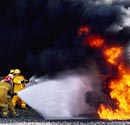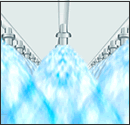|
 The fascinating world of nozzles The fascinating world of nozzles
Nozzle products have traditionally
been categorized into types according
to the kinds of fluids—water,
oil, air, etc.—to be sprayed,
and to the conditions under which
these fluids will be sprayed. These
days, however, several hundreds of
thousands of different kinds of nozzles
are produced around the world. Observing
the unusual shape of certain nozzles—spiral
nozzles being a case in point—one
might have to ask, "Is this really
a nozzle?"
The availability of a wide range of
nozzles, however, makes it possible
for us to select exactly the right
nozzle for the task it will be required
to perform.
In the following section, we offer
some examples that prove just how
useful nozzles can be in a number
of specific fields:
 |
 Nozzles save lives, protect property Nozzles save lives, protect property
Without modern fire extinguishing equipment, much preventable loss of life and property would occur. Both ceiling-mounted sprinkler systems and fire hoses rely on nozzles for their operation. By law, high buildings, highway tunnels, and underground areas must be equipped with automatic fire prevention systems. Such systems keep fire damage to a minimum and save lives.
|
 |
 Nozzles can even spray acids Nozzles can even spray acids
Nozzles are made of a variety of different materials. Titanium—the metal from which aircraft engines and airframes are made—is able to withstand the highly corrosive effects of hydrochloric acid and sulfuric acid; consequently, titanium nozzles are produced especially for chemical factories, where the ability to spray these liquids is required.
Even highly resilient stainless steel can only withstand the erosive and abrasive effects of fluids such as muddy water for a matter of months; ceramic, however—the material from which earthenware, porcelain, and tile are made—can be used to make nozzles for this purpose that will not need replacement for several years. |
 |
 Diamond nozzles cut stone with water Diamond nozzles cut stone with water
A thread-like stream of water, forced through a nozzle at a pressure 300~500 times greater than that produced by a fire hose, can be used to cut metal, stone, or any hard material. Nozzles for such purposes are manufactured from artificial ruby or diamond—the hardest known materials. Even these materials, however, can only withstand water running through them at such high pressure for several hours. Under the same conditions, a stainless steel nozzle orifice (the opening through which the fluid is discharged) would wear out in minutes—despite the fact that stainless steel is tough enough to be the material from which knife blades are commonly made.
|
Various nozzles (one of the examples)
|















